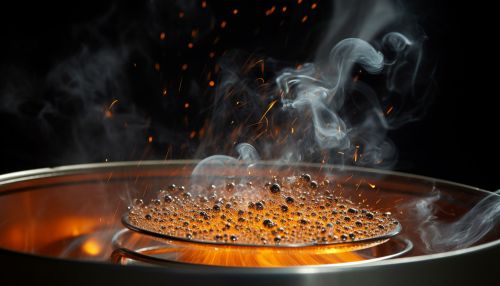Diffusion
Introduction
Diffusion is a fundamental concept in the fields of physics, chemistry, and biology. It refers to the process where particles spread out from an area of high concentration to an area of low concentration. This process continues until the concentration of particles is uniform throughout the system. Diffusion is a result of the kinetic properties of particles of matter, which are in constant motion due to thermal energy.
Physical Principles
The physical principles behind diffusion can be explained by the kinetic theory of gases. According to this theory, particles are in constant random motion and collide with each other and the walls of their container. The speed of these particles is directly proportional to their absolute temperature. When a gas is heated, the kinetic energy of the particles increases, and they move more rapidly, leading to a higher rate of diffusion.


Factors Affecting Diffusion
Several factors affect the rate of diffusion, including temperature, pressure, concentration gradient, and the size and mass of the particles.
Temperature
As the temperature increases, the kinetic energy of the particles also increases. This leads to more rapid movement and a higher rate of diffusion.
Pressure
An increase in pressure reduces the volume available to the gas particles, which increases their concentration and the rate of diffusion.
Concentration Gradient
The concentration gradient refers to the difference in concentration between two areas. The greater the concentration gradient, the faster the rate of diffusion.
Particle Size and Mass
Smaller and lighter particles diffuse faster than larger, heavier particles. This is because smaller particles have higher speeds at a given temperature, according to the kinetic theory of gases.
Types of Diffusion
There are several types of diffusion, including simple diffusion, facilitated diffusion, and active transport.
Simple Diffusion
Simple diffusion refers to the process where substances move across a membrane from an area of high concentration to an area of low concentration without the aid of membrane proteins.
Facilitated Diffusion
In facilitated diffusion, substances move across a membrane with the help of specific carrier proteins. This process is still driven by the concentration gradient, but the carrier proteins facilitate the movement of substances that cannot diffuse through the membrane on their own.
Active Transport
Active transport is a type of diffusion that requires energy. Substances are moved against their concentration gradient, from an area of low concentration to an area of high concentration. This process is facilitated by specific carrier proteins and requires energy in the form of ATP.
Diffusion in Biology
In biology, diffusion is a critical process that facilitates the transport of substances within cells and between cells and their environment. It is essential for many biological processes, including respiration, digestion, and cell signaling.
Diffusion in Chemistry
In chemistry, diffusion is an important process that influences reaction rates. When two gases are mixed, the molecules of each gas diffuse and eventually become uniformly distributed. This process is fundamental to many chemical reactions, particularly in gaseous systems.
Diffusion in Physics
In physics, diffusion is studied in the context of statistical mechanics and thermodynamics. It is a key concept in understanding heat transfer, the behavior of gases, and the properties of solids.
